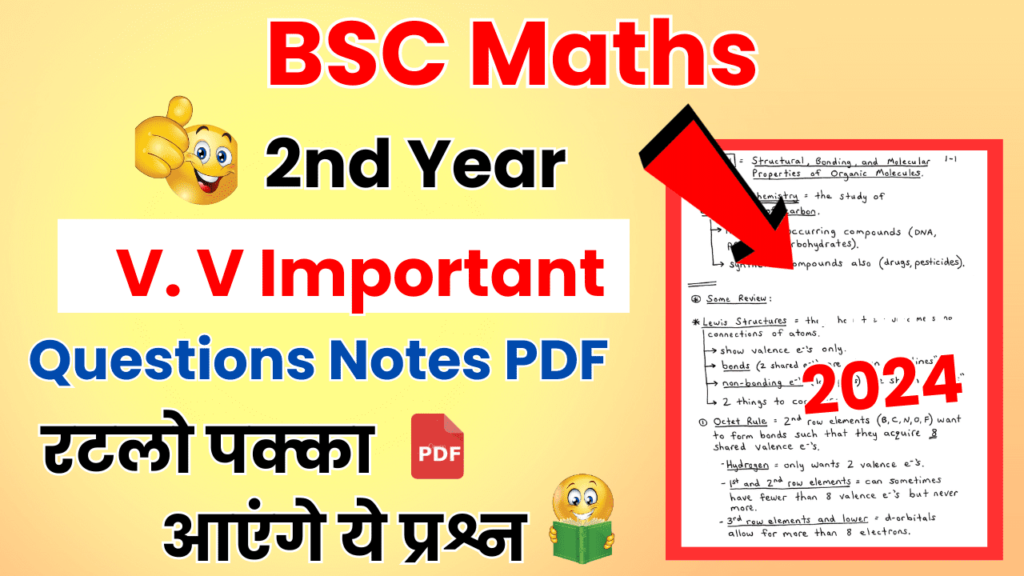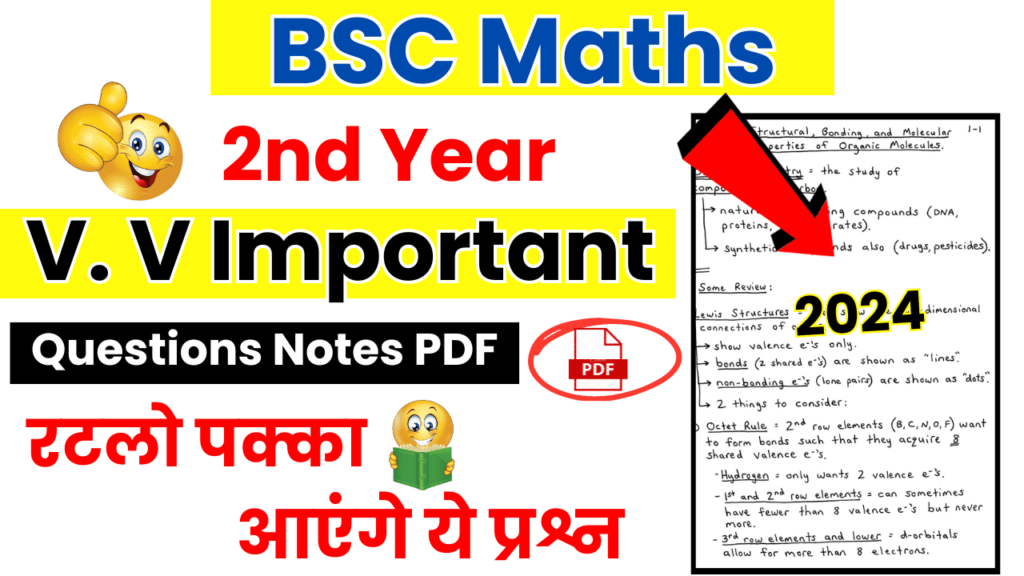Studying BSC 2nd Year Maths important question notes is Good for your Exam Preparation. They Can Help You To Cover Maximum Syllabus In Minimum Time.
Maths Is A Difficult Subject if You Lack Knowledge About Its Understanding. In This Post We Have Compiled Some important BSC 2nd Year Maths important question which are very helpful for your studies.

These questions provided here follows the exact pattern of a math paper conducted by Educational Institutions. Students You can use these Important questions For Practise Purpose as maths bsc 2nd year model paper.
All the questions, we are providing are from Bsc Second Year Math First Paper, Bsc Second Year Math Second Paper & Bsc Second Year Math third Paper. So don’t miss anything and read full post.
These Important Question Mentioned Here Are Extracted From Previous Year Question Papers And They Help You Learn Important Knowledge about Your Syllabus…
Contents
BSC 2nd Year Maths important question Notes

| Course | BSC (Bachelor of Science) |
| Subject | Maths |
| Content | Important Questions |
| Provide by | Hindijankaripur |
| Official Site | Hindijankaripur.com |
| Telegram | https://t.me/studentcafeindia |
Bsc Second Year Math First Paper
Explain the difference between a function and a relation. Provide examples to illustrate when a relation is a function and when it is not.
Define the composition of two functions and provide an example to show that the composition of functions is not commutative, i.e., (g o f) ≠ (f o g)[[9]].
Discuss the concepts of domain and range of a function. Use the function f(x) = 1/(x + 3) to illustrate how to find its domain and range.
Define what it means for a function to be invertible. Show that the function f(x) = 4x + 3 is invertible and find its inverse.
Explain how to perform operations on functions such as addition and division. Use the functions f(x) = x^2 and g(x) = 2x + 1 to find (f + g)(x) and the functions f(x) = √x and g(x) = x to find (f/g)(x)[[11]][[12]].
Define a bijection and provide criteria for a function to be bijective. Verify whether the function f: N → N: f(x) = 2x is a bijection.
Discuss the conditions under which two functions are considered equal. Use the functions f: Z → Z: f(x) = x^2 and g: Z → Z: g(x) = |x|^2 to show that f = g.
Explain the concept of inverse functions with examples. Demonstrate that the function f = {(2, 7), (3, 9), (4, 11), (5, 13)} is invertible and find its inverse.
Discuss the characteristics of quadratic functions and their graphs. Use the function f: N → Y: f(x) = 4x^2 + 12x + 15 to show that it is invertible and find its inverse.
Explain how bijections are related to inverse functions. Show that the function f: R – {0} → R – {0}: f(x) = 1/x is a bijection and discuss its implications.
Bsc Second Year Math Second Paper
Define a Cauchy sequence and prove that every convergent sequence is a Cauchy sequence.
Use Euler’s method to approximate the solution of a differential equation with a given initial condition and compare it with the tangent line approximation.
Use Gaussian elimination to solve the system of equations and then use back substitution to find the values of the variables a) 4x – 5y = -6 b) 2x – 2y = 1
Demonstrate how to set up an augmented matrix and place it in row-echelon form for the system:
- 2x – y + 3z = 9
- x + y + z = 6
- x – y + z = 2
Solve a linear system in three variables using matrix methods and place the augmented matrix in reduced row-echelon form
Gauss Elimination Method: Solve the following system of equations using the Gauss elimination method:
- x + y + z = 9
- 2x + 5y + 7z = 52
- 2x + y – z = 0
Approximate the solution of a differential equation using Euler’s method with an initial condition of y(2) = 3 and a step size of 0.1
Bsc Second Year Math Third Paper
Given a matrix A, find the eigenvalues and eigenvectors of A. Use these eigenvectors to form the matrix P and verify if A is diagonalizable using P.
Prove that a transformation T is linear by showing that T(x + y) = T(x) + T(y) and T(ax) = aT(x) for any vectors x, y in V3(R) and any scalar a.
Given a set S = {(1, 0, –1), (1, 2, 1), (0, –3, 2)}, prove that the vectors in S are linearly independent and verify that the rank of the matrix formed by these vectors is equal to the number of vectors, indicating that S forms a basis for V3(R)[[9]][[10]].
Calculate the transformation T applied to each basis vector from a set S to obtain the corresponding transformed vectors. Use these transformed vectors to form the matrix representation of T with respect to the basis B.
Transform a given matrix A into row-reduced echelon form to determine its rank and nullity.
Given a system of linear equations, represent the system in matrix form as AX = B. Reduce the augmented matrix [A| B] to row-echelon form to determine the nature of the solution set.
Demonstrate that a set V does not satisfy the closure property under addition, which is a requirement for a set to be a vector space. Provide a specific example to illustrate the violation of the closure property.
Calculate the characteristic polynomial of a matrix A to find its eigenvalues. Solve the characteristic polynomial to obtain the eigenvalues of A.
Given a set of vectors, form the corresponding matrix and reduce it to row-echelon form to determine the linear dependence or independence of the vectors.
Given a set of polynomials, construct a matrix with the coefficients of the polynomials and reduce it to row-echelon form to determine their linear independence.
Also Read:
BSC 6th Semester maths important questions
BSC 5th Semester maths important questions
BSC 4th Semester maths important questions 2024
We hope that with the help of this article you would have got information about BSC 2nd Year Maths important question notes.
Friends, how did you like this post, please let us know in the comment section and if you have any questions, then feel free to ask us in the comment box. If you found this post useful please share it with others.